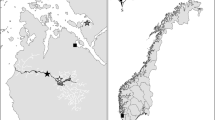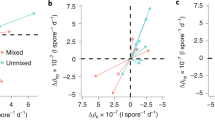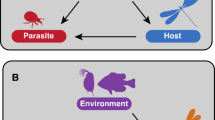Summary
In the laboratory, the two species of copepodsLepeophtheirus thompsoni andLepeophtheirus europaensis, ectoparasites of flatfishes, can meet and mate on at least one host species. In the wild however, these two species are found isolated on their sympatric hosts. Habitat selection theoretically represents a powerful enough mechanism to explain the maintenance of genetic heterogeneity in the wide sense. In this paper, the host colonization process is studied for both parasite species. It is shown that each parasite can develop and reach adult age on each host species. However,L. thompsoni is highly selective; it almost totally refuses to colonize hosts other than its natural one.Lepeophtheirus europaensis, on the contrary, readily infests turbot and brill in single-host experiments, but strongly prefers the brill when it has a choice. It appears that these two genetic entities are sympatrically maintained due to strong habitat selection. Such a pattern could theoretically only occur in a soft-selection context (density dependence). This point is discussed with respect to the different patterns in host use found in the geographical distribution of these parasites.
Similar content being viewed by others
References
Boxshall, G.A. (1974) Infections with parasitic copepods in North Sea marine fishes.J. Mar. Biol. Ass. UK 54, 355–72.
De Meeûs, T., Renaud, F. and Gabrion, C. (1990) A model for studying isolation mechanisms in parasite populations: the genusLepeophtheirus (Copepoda, Caligidae).J. Exp. Zool. 254, 207–14.
De Meeûs, T., Michalakis, Y., Renaud, F. and Olivieri I. (1993) Polymorphism in heterogeneous environments, evolution of habitat selection and sympatric speciation. Soft and hard selection models.Evol. Ecol. 7, 175–98.
Dempster, E.R. (1955) Maintenance of genetic heterogeneity.Cold Spring Harbor Symp. Quant. Biol. Sci. 20, 25–32.
Doyle, R.W. (1975) Settlement of planktonic larvae: a theory of habitat selection in varying environments.Am. Nat. 109, 113–26.
Futuyma, D.J. and Moreno, G. (1988) The evolution of ecological specialisation.Ann. Rev. Ecol. Syst. 19, 207–33.
Garcia-Dorado, A. (1986) The effect of niche preference on polymorphism protection in a heterogeneous environment.Evolution 40, 936–45.
Hedrick, P.W. (1990) Genotypic habitat selection: a new model and its application.Heredity 65, 145–9.
Johannessen, A. (1978) Early stages ofLepeophtheirus salmonis (Copepoda, Caligidae).Sarsia 63, 169–76.
Jones, J.S. and Probert, R.F. (1980) Habitat selection maintains a deleterious allele in a heterogeneous environment.Nature 287, 632–3.
Kabata, Z. (1972) Developmental stages ofCaligus clemensi (Copepoda; Caligidae).J. Fish Res. Bd Canada 29, 1571–93.
Levene, H. (1953) Genetic equilibrium when more than one ecological niche is available.Am. Nat. 87, 331–3.
Lewis, A.G. (1963) Life history of the caligid copepodLepeophtheirus dissimulatus Wilson, 1905 (Crustacea, Caligoida).Pacific Sci. 17, 195–242.
Maynard Smith, J. (1962) Disruptive selection, polymorphism and sympatric speciation.Nature 195, 60–2.
Maynard Smith, J. (1966) Sympatric speciation.Am. Nat. 100, 637–49.
Maynard Smith, J. and Hoekstra, R.F. (1980) Polymorphism in a varied environment: how robust are the models?Genet. Res. Camb. 35, 45–57.
Norman, J.R. (1934)A Systematic Monograph of flatfishes (Heterosomata) Vol. 1:Psettodidae, Bothidae, Pleuronectidae. British Museum (ed.), London, UK.
Quignard, J.P. (1972). La Méditerranée, creuset ichthyologique.Bull. Zool. 45, 23–36.
Rausher, M.D. (1984) The evolution of habitat preference in subdivided populations.Evolution 38, 596–608.
Rice, W.R. (1987) Speciation via habitat specialisation: the evolution of reproductive isolation as a correlated character.Evol. Ecol. 1, 301–14.
Rice, W.R. (1989) Analyzing tables of statistical tests.Evolution 43, 223–5.
Rosenzweig, M.L. (1991) Habitat selection and population interactions: the search for mechanisms.Am. Nat. 137, S5-S28.
Scherrer, B. (1984)Biostatistique. Gaêtan Morin. Chicoutimi, Canada.
Sokal, R.R. and Rohlf, F.J. (1981)Biometry. Freeman and Co, New York.
Zeddam, J.L., Berrebi, P., Renaud, F., Raibaut, A. and Gabrion, C. (1988) Characterisation of two species ofLepeophtheirus (Copepoda, Caligidae) from flatfishes. Description ofLepeophtheirus europaensis sp. Nov.Parasitology 96, 129–44.
Author information
Authors and Affiliations
Rights and permissions
About this article
Cite this article
de Meeûs, T., Hochberg, M.E. & Renaud, F. Maintenance of two genetic entities by habitat selection. Evol Ecol 9, 131–138 (1995). https://doi.org/10.1007/BF01237752
Issue Date:
DOI: https://doi.org/10.1007/BF01237752




